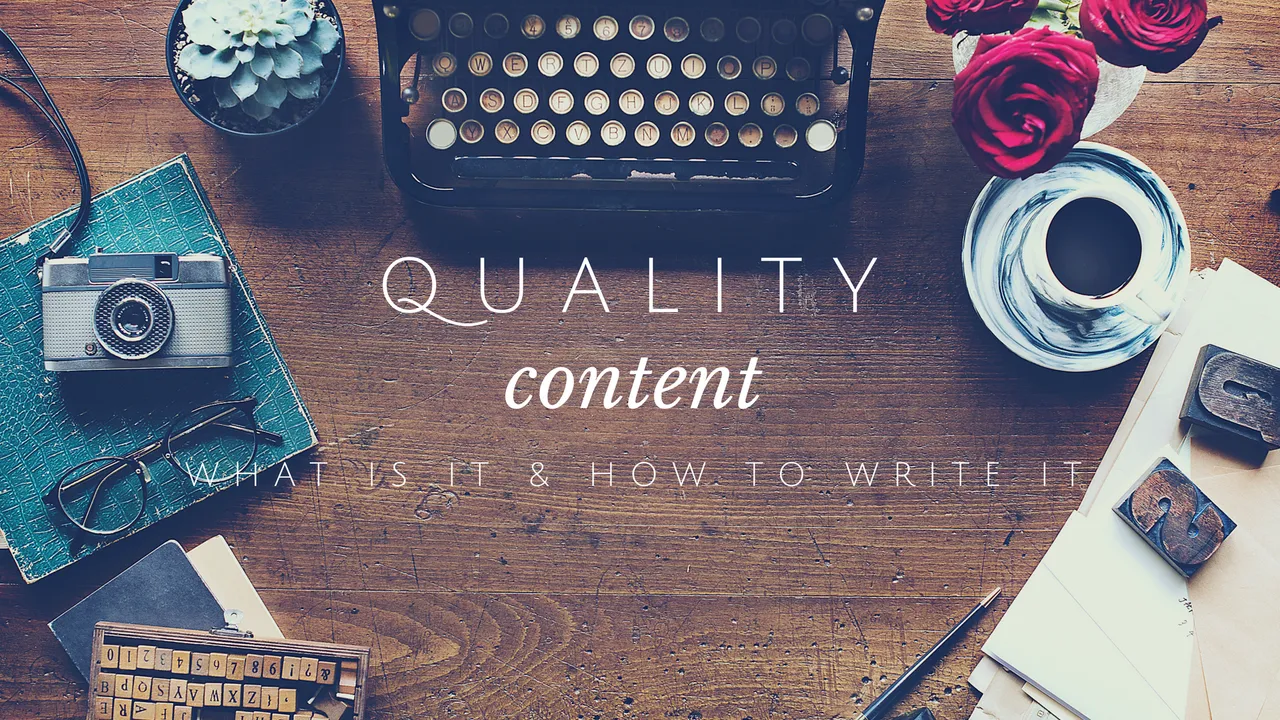Finally discover the six must-have features of quality content.

"I still don't understand what quality content is."
That's a comment I saw on a Steemit post in the past week. The person who said it has been around for at least two months and has been active both writing and commenting. I found it a bit distressing because it shouldn't take that long to figure out what it is. But the trouble is, when you ask what it is, it's hard to find a simple answer. It seems like the famous saying, "I can't define it, but I know it when I see it."
There's more to it than just writing well without typos or poor grammar (you should always do that). But what else should a quality post include?
It's a problem beyond Steemit. Anyone who publishes content on the web faces the same question. So I went on a mission to define it for bloggers, especially those on this platform.
Who's the judge?
Who is it that decides what quality content is, and what it isn't? That's the first question I needed to answer. And guess what I found? Almost every resource or authority site on developing good content referred to Google. I'm talking about big names like Forbes, Content Marketing Institute, Hubspot, Kissmetrics and LifeHack.org. Of course, each of them had their own spin on the topic.
But it seems that what makes Google happy, will also make readers happy. At least that is Google's goal, and the reason they have such an impact on what people consider to be quality content.
What I did next was comb through a bunch of the articles looking for commonalities. I pulled out the following list of attributes everyone seemed to agree makes quality content.
It must be original
Original is defined as:
Created personally by a particular artist, writer, musician, etc.; not a copy.
Whatever content you create needs to meet this definition. You need to create it. That doesn't mean you can't be inspired by someone, or even use them as a reference (properly sourced of course). But the content you post needs to have originated from your own mind, in your own words, images, music or video. It's just that simple.

Be informative
The best content serves a purpose. It answers a question, solves a problem, inspires, or entertains. You want to add value to the community or the subject you're writing about (or creating videos for).
People want to hear what you have to say, but say it in a focused way. Rambling about your grocery list probably isn't something that adds value - unless it's a humorous story that will entertain. The point is that posts don't need to be research papers to offer value, but they do need to have a purpose.
Make it "long enough"
How long is long enough is a question everyone asks. There is no absolute answer in terms of the number of words or video length. The content should be long enough to make your point while keeping the reader/viewer engaged.
The trouble is that it will vary by topic, the purpose of the post, the audience, the expertise of the author and even change over time. But while there are no firm numbers to go by, you can gauge what it should be by doing a little research on other posts on your topic.
The one thing that is universally agreed is you should never "fluff" your content to make it longer just for the sake of making it longer (to meet some arbitrary word count for example).
Always cite your sources
If you make reference to any outside sources, you need to link to them or give them appropriate credit. Citing your sources actually gives you more credibility.
How you do that is up to you. For example, you can use an in text reference such as "Dr. Acme, in an interview with the ABC newspaper..." This tells the reader immediately who and what your source is. Also, including a link to the source is good practice.
Alternatively, some people include links at the end of their posts or videos which is also acceptable.
Of course, if you're posting a complete work of fiction, poetry or personal experience, then sourcing isn't necessary unless you rely on a source somewhere in your content.

Include some visual content
According to Forbes, "visual content outperforms text-only content in terms of attracting inbound links, social media shares, time spent on page, and engagement."
Using images or video in your content almost always makes it more enjoyable for the reader which leads to a higher perceived quality. A massive block of text can be quite intimidating, even if it is formatted well for the web.
And if you use video, also remember to include some text. Describe your video, give it a proper introduction, or include other relevant facts. When you do so, you'll make everyone (or as close to everyone as you can) happy because some people won't watch videos - or they can't at that moment.
Format it for the web
Reading on electronic devices is hard on the eyes. So have some sympathy for your readers and use short paragraphs of 3-5 sentences. Include a line break between paragraphs (hit enter between them). Break up your post into sections using subheadings that describe the content as well as support skimming.
Also, remember many people are reading on mobile devices where even short paragraphs can appear long on small screens. Stick to just a few sentences though, and your post should be easy enough to read on any screen.
Is that it?
There's plenty of room for argument about other attributes quality content should have. The six I chose are the core ones I think you should strive for in every post.
What do you think? Did I pick the right ones? How do you define quality content?
 @ntowl , The Night Owl Writer
@ntowl , The Night Owl Writer
“We have loved the stars too fondly to be afraid of the night.” - the old astronomer